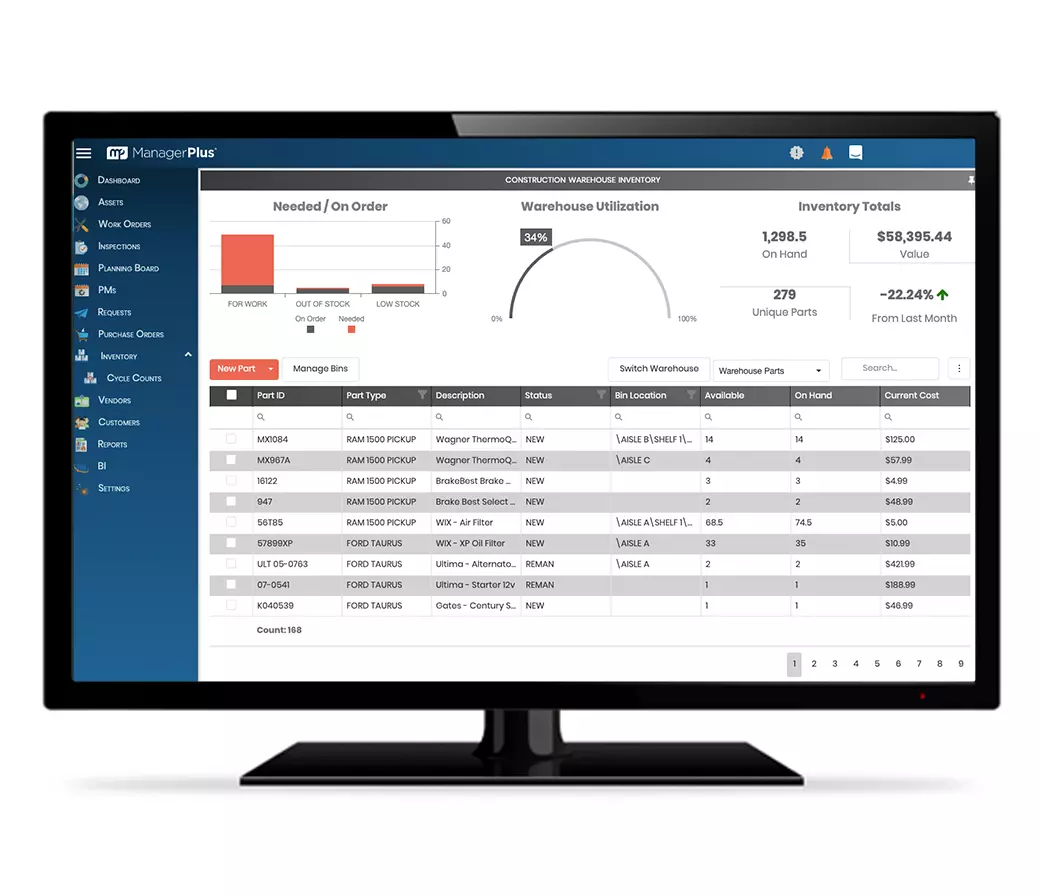How do you increase the value of your properties, improve tenant retention, and steadily increase revenue when you own huge multifamily residences? Through routine apartment maintenance.
As the number and size of buildings you own goes up, demands for maintenance at all levels will go up too. Managing that maintenance, from major HVAC renovations to individual tenant work orders, is a key part of improving your investment.
So you know actually getting the maintenance done is valuable, but it’s equally important to find efficient ways to track, organize, and manage work orders and other major maintenance needs.
What is apartment maintenance?
Apartment maintenance is the repair, replacement, or renovation of apartments, mass tenant complexes, or other buildings. It covers just about anything from individual unit repairs to sweeping improvements, like redoing the floors in a whole building or resurfacing a parking area.
Typical apartment maintenance happens in the form of tenant work orders, where maintenance managers handle small repairs and individual issues.
They can also come in building or complex-wide orders, where you need to coordinate the actual maintenance as well as providing notice or temporary changes to tenant accommodations.
Apartment managers and complex owners are also on the hook for maintaining a habitable environment, usually by law. That means the bare minimum level of maintenance required for providing reasonably safe accommodations is a must.
What is preventative maintenance in apartments?
Preventive maintenance is any kind of maintenance you undertake in order to prevent bigger issues, or to maintain safety standards and improve standard of living. It also sometimes refers to building and property improvements or maintenance that focus on increasing value.
A good example of preventative maintenance is yearly plumbing and waterline checks, preventative pest control measures, or routine exterior changes like repainting or landscaping.
Generally, the goal is to make the apartments more appealing to current and prospective tenants while satisfying any kind of local or national regulatory laws that govern multifamily residential complexes.

How do you assess the value of apartment maintenance?
There are a handful of ways to gauge the overall value that apartment maintenance contributes to your revenue and investment.
You reduce the impact of property aging, make apartments more appealing to current and potential renters, and you can avoid potential fines or renter suits against your company by preemptively addressing dangerous or risky maintenance issues.
- Reduce property aging
- Increase appeal to renters
- Avoid fines
Extend property value and reduce the effects of aging
There are a number of ways to value rental properties, one of which is the Capital Asset Pricing Model (CAPM), which assesses potential risks and benefits against the value of the property as a whole.
Here’s a good way to think about CAPM:
A property is worth about $100. Then you make a list of all the pros (benefits) and cons (risks) for that property, and you add or subtract dollars accordingly. Add a dollar for each pro, remove a dollar for each con.
After adding all the pros and subtracting all the cons, you’re left with a number that should represent the true value of a property under the CAPM model of rental property valuation.
One of the most common and sizable risks is property age. Older buildings, or complexes with outdated fixtures and amenities, are considered a higher risk because they’re likely to incur more regular and more expensive maintenance costs throughout the property’s ownership and investment lifecycle.
Preventative apartment maintenance, or even simple routine apartment maintenance, is a good way to help circumvent some of this risk by keeping buildings fixed up.
By providing regular maintenance, you can slowly improve the building while simultaneously preventing larger costs associated with unexpected or major repair and replace situations.
Increase renter retention and attract more tenants
If you want to actively raise the value of your properties, apartment maintenance also covers repainting, landscaping, the installation of newer appliances or more modern interiors.
The value here is twofold: you raise the literal value of your property by making steady improvements to the physical space and building, and you make the building more appealing to potential and current renters.
Keeping up with modern amenities and features will help with tenant and renter retention, so you can rely on a continual rent-based income. It also gives you the opportunity to raise rent rates and attract new renters by presenting a competitive, modern, and well kept complex.
Avoid fines, legal fees, and regulatory probes
As an indirect means of preserving or increasing property value, you can avoid potential lawsuits or fines by ensuring that apartment maintenance is performed on a routine basis.
With this, you’ll be able to catch potential problems before they cause injury or lead to complaints. Legal trouble or fines from local government and housing agencies can eat into your overall revenue.
For example, premises liability law could make you responsible for any injuries or damages associated with unsafe living conditions. While it might not seem like a top priority to fix a creaky set of stairs, it could save you tons by preventing an injury lawsuit.
Multiply that potential cost mitigation by every apartment, building, and complex you own, and it stacks up quick.
How do I manage apartment maintenance?
Traditionally, apartment maintenance management varies by the size and needs of your property. Smaller facilities, something like an apartment complex with fewer than 50 apartments, likely have a very small maintenance staff operated through a local office.
Larger facilities, or for companies and owners with multiple complexes spread across a state or several states, need a more comprehensive and trackable approach.
To manage the demand for work orders, planned maintenance, and the need to keep track of maintenance processes increases, many companies rely on work order management software.
With good work order software, you can:
- Schedule and organize maintenance requests
- Track and record apartment maintenance costs
- Review your data for better insights on improved work processes
- Access reporting and task tracking on a company-wide scale
Managing apartment maintenance for thousands of units across any number of residential complexes calls for a more efficient system. Relying on paper work orders or simple spreadsheet software falls short in many cases, putting a strain on management.
For example, every time a paper work order passes from one person to the next, it’s a chance to lose track of that work. Losing track of work orders like that can easily cascade, resulting in fewer completed maintenance requests, lost man hours, and wasted time trying to figure out where the process broke down.
Spreadsheets are slightly better, but at scale, there’s simply too much data to reliably sort and manage without some form of automated access and handling.

Develop a better apartment maintenance management system
Adding on to the proposed value of work order software, you need to consider a best practices setup for managing your apartment maintenance.
In particular, you should focus on several key areas:
Manage budgeting and expenditures
Maintenance has the potential to be an expensive component of property ownership. A number of financial resources suggest setting aside 1-3% of the property’s total value for maintenance costs each year, but this only accounts for average maintenance.
If you’re interested in improvements, or invested in a property with higher than average maintenance needs due to location or age, that number might go up even further.
So if you have a property worth $1,000,000 you’re looking at an average minimum maintenance budget of $10,000 to $30,000. That’s a lot of money tied up in paper work orders.
Track work order queue, duration, and efficiency
Tracking the duration and time spent on work orders is another vital element of apartment maintenance management.
You can create logs and track this information through ManagerPlus’ EAM software, which helps you assess a top down view of your apartment maintenance organization. See how your facility manager is organizing maintenance, or get reporting for individual technician performance.
If you want to optimize further, ManagerPlus’ maintenance management software includes tools for automatically generating technician assignments, tracking work order submission and completion times, and options to compile this information in a single-view dashboard.
Organize documents and asset status reports
Organize all of your documentation, asset reports, and other records by transitioning from paper to digital.
Digital document collections make it easy to refer to records when and where you need them, including floor plans or past work orders. Moving beyond paper not only reduces the risk of information loss, it lets you save time with a series of filters and grouping features.
If you want to check the status of a particular asset, or compare asset statuses across a number of your facilities, you can. Say your HVAC system is due for a routine tune up soon, and you want to see how your other HVAC systems are doing across several buildings. You can do that too.
Apartment Maintenance Summary
Apartment maintenance is an integral part of owning and operating any number of multifamily residences, apartment complexes, or other buildings.
Good apartment maintenance helps you:
- Boost property value, revenue, and reduce risk
- Increase renter retention
- Improve maintenance organization
As your business scales, keeping track of that maintenance is only going to get more complicated, which is why a piece of software like ManagerPlus is useful.
ManagerPlus helps you optimize, organize, and keep track of maintenance needs across your entire organization. Streamline your apartment maintenance program and skip the disorganization with a better solution for facility and property maintenance.


